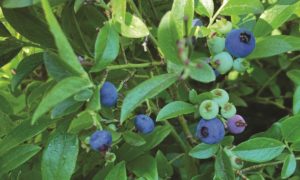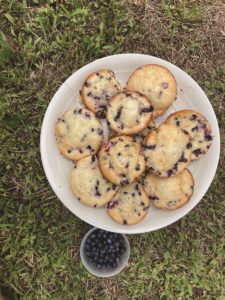TRURO — I wasn’t sure what to expect when my boyfriend, Miles, headed down an unfamiliar sandy path lined with scrubby green underbrush. “Follow me,” was all he said. We were near the shores of the Pamet River and not far from his family’s Truro saltbox where we are stationed for the summer.
When he stopped short beneath a tall bush and pointed, I saw only an ordinary-looking shrub. Its small leaves were lovely enough, I thought, but nothing special. Then, leaning closer, I noticed clusters of pale berries hanging from the ends of its branches. The low groundcover, too, was peppered with similar clusters. We were surrounded by yet-to-ripen wild blueberries.

“Just wait till July,” Miles said.
July has finally arrived, and that sandy path has become a familiar one. The berries are especially abundant this year, according to Miles.
Native to northeastern North America, wild blueberries are smaller and more flavorful that those we buy in the grocery store. On the Cape, two easily recognizable varieties can be found growing wild: the highbush Vaccinium corymbosum and the lowbush Vaccinium angustifolium, though hundreds of variations exist within these categories.
The highbush berry has been domesticated for about 100 years, and more recently it’s been genetically modified, which accounts for the uniform berries found at the Stop & Shop. But here, highbush berries still grow wild, often in the same sunny patches as the lowbush ones. While the high bushes grow as individuals and like to hang out near cranberry bogs and other water sources, the lowbush varieties tolerate drier areas and grow rhizomatically, spreading their roots and sprouting new branches horizontally.
Both varieties like acidic, sandy soils. Their ability to thrive in low-pH areas means that they absorb the plethora of minerals found here. Both do well in either full or partial sunlight.

Older branches of blueberry bushes can be pruned in early spring, when the plant is still dormant, to encourage healthy new growth, according to the UMass Amherst Center for Agriculture, Food, and the Environment. Native tribes of the northeast practiced controlled burns for the same reason. But whether you are pruning or just picking, be aware that this bush is a shared resource of a larger ecosystem: wild blueberries are a food source for birds, who in turn help to spread the blueberries’ seeds.
For those of us lucky enough to happen upon this tart cornucopia, wild blueberries of both heights offer double the antioxidants of cultivated blueberries, according to a 2008 Cornell University study. They can be enjoyed in countless ways, and the sooner you eat them, the more vitamins they retain.
I’ll admit that I’m partial to eating berries directly off the branch, no basket involved. But this summer, I’ve been lucky to enjoy them in warm blueberry muffins, courtesy of Miles’s mother, Meg Chaplin.
When the three of us returned to the berry patch two weeks ago, it was a rainbow of blues, pinks, and greens, offering us not only berries for that morning’s muffins but the promise of berries for weeks to come.
Picking enough berries for a batch of muffins takes a while. But it’s a labor of love that’s twice rewarded. Go out to fill your basket in the morning. As you lean over the bushes, feel the cool salty air of the morning give way to the warmth of the sun as it rises overhead. Then head home to make these.

Meg Chaplin’s Wild Blueberry Muffins
Makes one dozen
2 cups wild blueberries
¼ cup butter, softened
1 cup sugar, plus a little more for sprinkling the tops
2 eggs
2 tsp. baking powder
1 tsp. vanilla extract
½ tsp. salt
2 cups flour
½ cup whole milk
Heat oven to 350 degrees F. In a medium-size mixing bowl, cream softened butter and sugar using an electric mixer or a wooden spoon.
Add two eggs and mix well, being careful not to leave any lumps. Add baking powder, vanilla extract, and salt. Mix.
Mix in a cup of flour and ½ cup of milk. Add the second cup of flour and mix again. Gently stir in your lovingly picked wild blueberries.
Butter a muffin tin and fill cups with batter about two-thirds of the way full. Sprinkle a little granulated sugar on top of each muffin. Bake for 18 minutes. Try to let them cool at least a little before eating.
